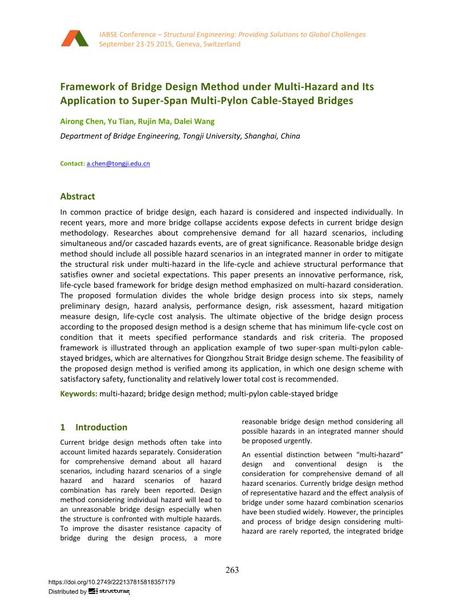Framework of Bridge Design Method under Multi-Hazard and Its Application to Super-Span Multi-Pylon Cable-Stayed Bridges

|
|
|||||||||||
Bibliographic Details
| Author(s): |
Airong Chen
(Department of Bridge Engineering, Tongji University, Shanghai, China)
Yu Tian (Department of Bridge Engineering, Tongji University, Shanghai, China) Rujin Ma (Department of Bridge Engineering, Tongji University, Shanghai, China) |
||||
|---|---|---|---|---|---|
| Medium: | conference paper | ||||
| Language(s): | English | ||||
| Conference: | IABSE Conference: Structural Engineering: Providing Solutions to Global Challenges, Geneva, Switzerland, September 2015 | ||||
| Published in: | IABSE Conference Geneva 2015 | ||||
|
|||||
| Page(s): | 263-271 | ||||
| Total no. of pages: | 9 | ||||
| Year: | 2015 | ||||
| DOI: | 10.2749/222137815818357179 | ||||
| Abstract: |
In common practice of bridge design, each hazard is considered and inspected individually. In recent years, more and more bridge collapse accidents expose defects in current bridge design methodology. Researches about comprehensive demand for all hazard scenarios, including simultaneous and/or cascaded hazards events, are of great significance. Reasonable bridge design method should include all possible hazard scenarios in an integrated manner in order to mitigate the structural risk under multi-hazard in the life-cycle and achieve structural performance that satisfies owner and societal expectations. This paper presents an innovative performance, risk, life-cycle based framework for bridge design method emphasized on multi-hazard consideration. The proposed formulation divides the whole bridge design process into six steps, namely preliminary design, hazard analysis, performance design, risk assessment, hazard mitigation measure design, life-cycle cost analysis. The ultimate objective of the bridge design process according to the proposed design method is a design scheme that has minimum life-cycle cost on condition that it meets specified performance standards and risk criteria. The proposed framework is illustrated through an application example of two super-span multi-pylon cable- stayed bridges, which are alternatives for Qiongzhou Strait Bridge design scheme. The feasibility of the proposed design method is verified among its application, in which one design scheme with satisfactory safety, functionality and relatively lower total cost is recommended. |
||||
| Keywords: |
multi-hazard bridge design method multi-pylon cable-stayed bridge
|
||||

